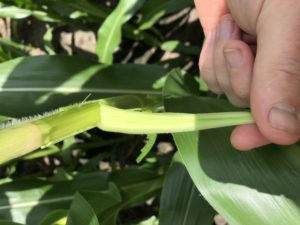How to Scout and Manage Stink Bugs in Pre-Tassel Corn
go.ncsu.edu/readext?700481
en Español / em Português
El inglés es el idioma de control de esta página. En la medida en que haya algún conflicto entre la traducción al inglés y la traducción, el inglés prevalece.
Al hacer clic en el enlace de traducción se activa un servicio de traducción gratuito para convertir la página al español. Al igual que con cualquier traducción por Internet, la conversión no es sensible al contexto y puede que no traduzca el texto en su significado original. NC State Extension no garantiza la exactitud del texto traducido. Por favor, tenga en cuenta que algunas aplicaciones y/o servicios pueden no funcionar como se espera cuando se traducen.
Português
Inglês é o idioma de controle desta página. Na medida que haja algum conflito entre o texto original em Inglês e a tradução, o Inglês prevalece.
Ao clicar no link de tradução, um serviço gratuito de tradução será ativado para converter a página para o Português. Como em qualquer tradução pela internet, a conversão não é sensivel ao contexto e pode não ocorrer a tradução para o significado orginal. O serviço de Extensão da Carolina do Norte (NC State Extension) não garante a exatidão do texto traduzido. Por favor, observe que algumas funções ou serviços podem não funcionar como esperado após a tradução.
English
English is the controlling language of this page. To the extent there is any conflict between the English text and the translation, English controls.
Clicking on the translation link activates a free translation service to convert the page to Spanish. As with any Internet translation, the conversion is not context-sensitive and may not translate the text to its original meaning. NC State Extension does not guarantee the accuracy of the translated text. Please note that some applications and/or services may not function as expected when translated.
Collapse ▲With corn shooting up, some fields are not too far away from tasseling. It is critical to scout all corn when the primary ear is growing and to protect it during the two weeks prior to tasseling. This recent blog post details important changes to the threshold that were made this year and provides guidance on how to scout and spray.
Our threshold for this stage of corn growth is based on sampling only a small part of the plant and is relative to the position of the primary ear. Furthermore, to properly use the threshold (and to prevent banana ear), the ear must be protected prior to tasseling and ear emergence. Therefore, finding the primary ear is a necessary part of scouting. Note that the location of the primary ear will depend on hybrid and environmental conditions. So it’s important to note this for each field that’s scouted.
To find the primary ear, locate where on the plant you expect the primary ear to form and begin carefully removing leaves by pulling back the collars. Except near the top of the plant, a small ear shoot should be visible behind each leaf. These ear shoots will be smaller lower down in the plant. Early in ear development, the top-most and largest of these ear shoots will begin to grow rapidly and, as the ear develops, you will be able to dissect it out of the ear shoot. If you can identify this area of the plant, then you have located the primary ear. If a secondary ear is forming, you will also notice ear shoot development in the node directly below the primary ear.



